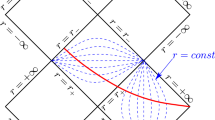Abstract
By applying a parabolic–hyperbolic formulation of the constraints and superposing Kerr–Schild black holes, a simple method is introduced to initialize time evolution of binary systems. As the input parameters are essentially the same as those used in the post-Newtonian (PN) setup the proposed method interrelates various physical expressions applied in PN and in fully relativistic formulations. The global ADMcharges are also determined by the input parameters, and no use of boundary conditions in the strong field regime is made.
Similar content being viewed by others
References
Y. Choquet-Bruhat, General Relativity and Einstein’s Equations (Oxford Univ. Press, Oxford, 2009).
A. J. Lichnerowicz, Math. Pures Appl. 23, 39 (1944).
J.W. York, Phys. Rev. Lett. 28, 1082 (1972).
T. W. Baumgarte and S. L. Shapiro, Numerical Relativity (Cambridge Univ. Press, Cambridge, 2010).
I. Rácz, Class. Quantum Grav. 33, 015014 (2016).
I. Rácz and J. Winicour, Phys. Rev. D 91, 124013 (2015).
I. Rácz, arXiv:1608.02283 (2016).
E. Bonning, P. Marronetti, D. Neilson, and R.A. Matzner, Phys. Rev. D. 68, 044019 (2003).
G. Lovelace, R. Owen, H. P. Pfeiffer, and T. Chu, Phys. Rev. D 78, 084017 (2008).
S. Ossokine, F. Foucart, H. P. Pfeiffer, M. Boyle, and B. Szilágyi, Class. Quantum Grav. 32, 245010 (2015).
J. Thornburg, Class. Quantum Grav. 4, 1119 (1987).
T. Chu, Phys. Rev. D 89, 064062 (2014).
G. Lovelace, Class. Quantum Grav. 26, 114002 (2009).
R. P. Kerr and A. Schild, Proc. Symp. Appl.Math. 17, 199 (1965).
H.-O. Kreiss and J. Lorenz, Initial-Boundary Value Problems and the Navier–Stokes Equations (Academic, Boston, 1989).
J. M. Bowen and J. W. York, Phys. Rev. D 21, 2047 (1980).
A. Garat and R. H. Price, Phys. Rev. D 61, 124011 (2000).
J. A. V. Kroon, Class. Quantum Grav. 21, 3237 (2004).
P. T. Chrusćiel, J. Corvino, and J. Isenberg, Commun. Math. Phys. 304, 637 (2011).
Author information
Authors and Affiliations
Corresponding author
Additional information
The article is published in the original.
Paper presented at the Third Zeldovich meeting, an international conference in honor of Ya.B. Zeldovich held in Minsk, Belarus on April 23–27, 2018. Published by the recommendation of the special editors: S.Ya. Kilin, R. Ruffini, and G.V. Vereshchagin.
Rights and permissions
About this article
Cite this article
Rácz, I. A Simple Method of Constructing Binary Black Hole Initial Data. Astron. Rep. 62, 953–958 (2018). https://doi.org/10.1134/S1063772918120302
Received:
Accepted:
Published:
Issue Date:
DOI: https://doi.org/10.1134/S1063772918120302




